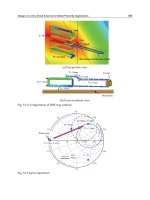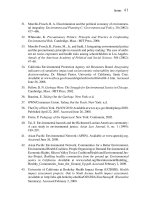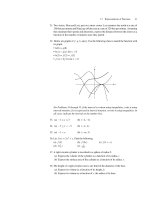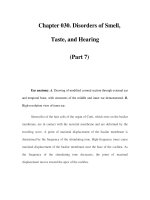Aircraft Design: Synthesis and Analysis - part 7 pps
Bạn đang xem bản rút gọn của tài liệu. Xem và tải ngay bản đầy đủ của tài liệu tại đây (8.85 MB, 62 trang )
actually be able to produce mush more thrust at low altitudes and speeds, but they are limited (often in
software) to lower thrust levels to extend engine life and reduce maximum loads. Thus some supersonic
engines show very little reduction in thrust from sea-level static conditions to Mach 1 at 30,000 ft.
Actual engine performance differs from the basic engine data in a number of ways. The air bled from the
compressor for air conditioning, the power extracted for hydraulic pumps and alternators, and inlet and
exhaust duct losses reduce engine thrust. The exact amount depends, of course, on the requirements of
the accessories, the engine size, and the inlet and duct design, but reasonable estimates for conventional
inlets are:
1) Thrust is reduced by 3.5% below engine specification levels
2) Specific fuel consumption is increased by 2.0%
During the take-off the air conditioning bleed is often shut-off automatically to avoid the thrust loss. The
remaining thrust loss is about 1%. If a long or curved (S-bend) inlet is involved as in center engine
installations, an additional thrust loss of 3% and a specific fuel consumption increase of 1-1/2% may be
assumed. This additional loss applies only to the affected engine.
Specific Fuel Consumption and Overall Efficiency
The engine performance may be described in several ways. One of the useful parameters is specific fuel
consumption, or s.f.c. For turbojets and fans, the s.f.c. is usually expressed as the thrust specific fuel
consumption or t.s.f.c It is defined as the weight of the fuel burned per unit time, per unit thrust. In
English units, t.s.f.c. is usually quoted in lbs of fuel per hour per lb of thrust or just lb/hr/lb or 1/hr. (In SI
units the t.s.f.c. is sometime expressed in kg/hr/kN.)
For turboprop or piston engines, the s.f.c. is often expressed as a power specific fuel consumption, i.e.
weight of fuel per unit time per unit power delivered to the propeller. This quantity is often denoted
b.s.f.c. (for brake-power s.f.c.) and has units of 1/length. It is expressed in the unwieldy, but familiar
English units of lb / hr / h.p
The overall efficiency of the propulsion system is given by:
η = Power Available to Aircraft / Rate of Energy Consumption = T V / w h
where T = thrust, V= aircraft speed, w = rate of fuel consumption (weight/unit time), and h = specific
energy of the fuel (energy / unit weight).
In terms of the s.f.c.: η = V / tsfc h.
One must be careful to use consistent units in this expression.
Overall efficiency of several engines vs. Mach number.
Overall efficiency vs. bypass ratio for large commercial turbine engines. (From Dennis Berry, Boeing)
Trends in advanced engine efficiency.
Subsonic Engine Efficiencies:
(At about min sfc throttle setting 80% at typical cruise conditions)
GE90 .361
PW4000 .348
PW2037 .351 (M.87 40K)
PW2037 .335 (M.80 35K)
CFM56-2 .305
TFE731-2 .234
Data on Large Turbofan Engines
These pages conatin some basic data and pictures of larger turbofan engines.
Cut-away showing the PW4000-Series of Engine
Cross-Section of GE-90 Engine
Some Basic Data
Engine SLS Thrust SLS SFC Max Diam Length Wt BPR Cruise sfc Applications
ALF502R-6 7500 0.415 50 65.6 1375 - - Bae-146
TFE731-2 3500 0.493 39.4 51 725 2.67 0.87 Citation
TFE731-20 3650 0.441 39.4 51 885 - - Lear 45
BR710 20000 0.39 52.9 87 3520 - - G-V, Global Express
AE3007 7580 0.39 43.5 106.5 1581 - -
Citation10, Embraer
RJ145
CFM56-2-
C1
22200 0.36 72 95.7 4635 6 0.64 A340
CF34-3B 9220 0.35 49 103 1670 -
Canadair Challenger,
RJ
CF6-
80C2B1F
58000 0.316 106 168 9499 0.605 B747-400
GE90-90B 90000 134 204 16644 9 .55 (est) B777-200/300
V2500-A1 25000 0.36 67.5 126 5210 5.4 0.543 A319-321
RB211-524H 60600 86.3 125 9499 4.1 0.603 747-400 / 767-300
Tay 620 13850 0.43 60 102 3185 3.04 0.69 Fokker 70/100
Trent 800 92000 0.35 110 172 14400 6.5 0.56 777
JT8D-217 20850 0.53 56.3 154 4430 1.74 0.71 MD-80
PW2037 38250 0.33 84.8 146.8 7160 5.8 0.563 757, C-17
PW4098 98000 112 191.7 16165 5.8 .56 (est) 777
FJ44-1 1900 0.456 20.9 41.9 445 CitationJet
FJ44-2 2300 23.7 40.2 448 3.28 Raytheon Premier
JT3-D-7 19000 0.55 52.9 134.4 4300 0.79
JT8D-11 15000 0.62 43 120 3310 0.82
JT9D-3A 43500 0.346 95.6 128.2 8608 0.6
ADP 65500 120 200 9500 12 0.53
Hypothetical 2015
Engine
ADP 70000 144 200 12500 20 0.49
GE4 69000 0.9 90 296.04 13243 1.47
B2707 SST Design
Mach 2
GE21J11B14 65000 0.8 74.16 282 1.35 SCAR study Mach 2.6
Olympus
593
38000 1.39 49 150 6780 1.195 Concorde
TBE-M1.6 70600 0.875 9252 1.12
NASA MACH 1.6
STUDY
TBE-M2.0 69000 0.873 9278 1.2
NASA MACH 2.0
STUDY
TBE-2.4 65500 0.929 9587 1.31
NASA MACH 2.4
STUDY
Rolls VCE 49460 0.55 1.1 HSCT Design Study
Rolls
Tandem
49460 0.55 1.09 HSCT Design Study
Small Engines Summary
There are not many engines in the 2000lb to 4000lb thrust class appropriate for small turbofan aircraft. Here is the list of all viable
turbofan engines (1K-10K lb thrust) currently in production or under development in the west (source: AW&ST, Janes, Web). Engines
that have afterburners or have very low bypass ratio (SFC of 1.0 and up) are not listed here.
Engine Thrust [lb] SFC D
Length Weight,lb
Application
Allied Signal
//www.alliedsignal.com/
F109-GA-100 1330 0.39 31" 44" 439
Squalus, Phoenix FanJet
TFE731 3500-5000 0.51 40 40" 50" 734-988
Cessna/Falcon/Lear/Astra
ATF3 5400 0.50 34" 103" 1120
Falcon, HU25
CFE 738 6000 0.37 48" 99" 1325
With GE. Falcon 2000
F124 6300 0.81 36" 70" 1100
Aero Vodochody L-139
ALF502/507 6700-7800 0.43-0.41 50" 65" 1350
Ch 600, Bae-146, AvroRJ
Allison
/>AE3007 7200 0.39 43" 106" 1580
Citation-X, Global-Hawk
General Electric
CF700 4500 0.65 37" 54" 767
Falcon, Sabreliner
CF/TF-34 9200 0.35 49" 103" 1670
Challenger 601/RJ,A-10
IHI (Japan)
F-3 3700 0.70 22" 79" 458
Kawasaki T-4
TF-40 7300 0.74 30" 114" 1690
Mitsubishi T-2, F-1
P&W/P&Wc/MTU
/>JT15D 3000 0.55 28" 61" 630
Citation 5, Beechjet 400
PW500/530/545 3000-4500 0.44 27" 70" 765
Citation Bravo, Excel
PW305/306 4500-6500 0.39 38" 81" 1040
Learjet 60
Williams/Rolls-Royce
//www.rolls-royce.com/
F107/F112 700 N/A 12" 40" 146
ALCM, Tomahawk
FJX-2 700 N/A 14" 41" 100
V-Jet 2
FJ44-1,2 1900-2300 0.456 21" 40" 445
Premier, Darkstar, SJ30
The FJX engine is currently being developed by Williams as part of a NASA program and has caused considerable excitement in the
general aviation community. Here are some recent updates from NASA.
The GAP Turbine engine (FJX-2) is on its way to becoming reality. Hardware is being built, components are being tested and
we expect to have the first complete engine ready for testing by August of this year. In addition to the FJX-2 turbofan, we are
developing a the turboprop version of the engine (TSX-2) for ground testing in 1999. The FJX-2 will be flight demonstrated in
the V-Jet II aircraft but the TSX-2 will not be flight tested as part of the GAP program, our main emphasis is on the fan version
of the engine. This engine has many unique design features with a KISS (keep-it-simple-stupid) design philosophy to keep the
costs down to the lowest possible level. This does not mean a low performance engine however, at less than 100 lbs. weight for
700 lbs. thrust and a fuel consumption rate per pound of thrust similar to larger modern turbofan engines this will be a world
class engine. The FAA is participating in the program to ensure that the new and innovative design features of this engine will
meet all certification requirements in a cost effective manner.
The first FJX-2 turbofan engine was fully assembled on December 18, 1998, by Williams International in Walled Lake,
Michigan, marking a major milestone in the GAP program. On December 22, 1998, the first operational test of the new FJX-2
engine was conducted in the Williams static test facility. The engine was then disassembled for inspection and found to be in
excellent condition. The engine is now being reassembled and will continue to be developed to a flight worthy status over the
next 18 months.
The development of the FJX-2 engine commenced in December 1996 under a Cooperative Agreement between NASA/GRC
and Williams International. The engine will be integrated into the V-Jet II concept aircraft and flight demonstrated at the EAA
Oshkosh AirVenture in late July 2000.
Selected Data on Supersonic Engines
From NASA AIAA 92-1027 TBE
Design Mach 1.6 2 2.4
SLSThrust (klb) 70.6 69 65.5
Engine Weight 9252 9278 9587
Total Weight 14595 15521 17424
Cruise sfc 1.118 1.199 1.31
Some thrust and sfc lapse rates: (From 92-1027, Concorde brochure, Boeing CR, SAE901890, SAE1892
)
M h T sfc eta source
0 0 70610 0.8746 0 AIAA92-1027
1.6 45000 29528 1.118 0.346
0 0 69035 0.8728 0 AIAA92-1027
2 55000 21911 1.1991 0.404
0 0 65482 0.9293 0 AIAA92-1027
2.4 65000 18955 1.31 0.443
0 0 38050 Concorde Brochure
2 60000 6791
0 0 52730 0 Boeing CR
0.9 30000? 42q 0.98 0.22
2.4 60000? 25q 1.28 0.454
2 1.2 0.403 SAE 1890
0 0 49460 0.548 0 Rolls VCE
0.95 31000 7868 0.845 0.279
1.3 35000 12930 0.902 0.351
2 60000 8711 1.1 0.44
0 0 1.39 0 Rolls Olympus Data
0.95 31000 1.025 0.23
1.3 35000 1.415 0.224
2 60000 1.195 0.405
0 0 49460 0.551 Rolls Tandem Fan
0.95 31000 7868 0.816 0.288
1.3 35000 12930 0.893 0.354
2 60000 8711 1.094 0.437
Overall engine efficiencies at cruise:
Mach eta eta_goal source
1.0 .38 .38 Douglas CR pg47
2.0 .42 .45 "
3.2 .46 .56 "
5.0 .50 .58 "
Some rough additional rules from a Rolls-Royce SNECMA paper:
Nacelle isolated drag = 4.6% T (friction) + 4.4% T (wave)
SLSTH/Weng = 5.28
TOThrust = .37 GTOW (Concorde)
Propulsion Systems: Installation
This section deals with engine installation issues for preliminary design. The detailed integration of
propulsion system and airframe is very complex, requiring some of the most sophisticated aerodynamic
tools that are currently available, but some of the basic considerations are discussed in the following
sections including:
Engine Placement
Nacelle Design and Engine Geometry
Supersonic Aircraft Engine Layout
Engine Placement
The arrangement of engines influences the aircraft in many important ways. Safety, structural weight,
flutter, drag, control, maximum lift, propulsive efficiency, maintainability, and aircraft growth potential
are all affected.
Engines may be placed in the wings, on the wings, above the wings, or suspended on pylons below the
wings. They may be mounted on the aft fuselage, on top of the fuselage, or on the sides of the fuselage.
Wherever the nacelles are placed, the detailed spacing with respect to wing, tail, fuselage, or other
nacelles is crucial.
Wing-Mounted Engines
Engines buried in the wing root have minimum parasite drag and probably minimum weight. Their
inboard location minimizes the yawing moment due to asymmetric thrust after engine failure. However,
they pose a threat to the basic wing structure in the event of a blade or turbine disk failure, make it very
difficult to maximize inlet efficiency, and make accessibility for maintenance more difficult. If a larger
diameter engine is desired in a later version of the airplane, the entire wing may have to be redesigned.
Such installations also eliminate the flap in the region of the engine exhaust, thereby reducing C
Lmax
.
For all of these reasons, this approach is no longer used, although the first commercial jet, the
deHavilland Comet, had wing-root mounted engines. The figure shows Comet 4C ST-AAW of Sudan
Airways.
The following figure, from the May 1950 issue of Popular Science, shows the inlet of one of the Comet's
engines. "Four turbine engines are placed so close of centerline to plane that even if two on one side cut
out, pilot has little trouble maintaining straight, level flight."
Wing-mounted nacelles can be placed so that the gas generator is forward of the front spar to minimize
wing structural damage in the event of a disk or blade failure. Engine installations that do not permit this,
such as the original 737 arrangement may require additional protection such as armoring of the nacelle,
to prevent catastrophic results following turbine blade failure. This puts the inlet well ahead of the wing
leading edge and away from the high upwash flow near the leading edge. It is relatively simple to obtain
high ram recovery in the inlet since the angle of attack at the inlet is minimized and no wakes are
ingested.
In the days of low bypass ratio turbofans, it was considered reasonable to leave a gap of about 1/2 the
engine diameter between the wing and nacelle, as shown in the sketch of the DC-8 installation below.
As engine bypass ratios have increased to about 6 - 8, this large gap is not acceptable. Substantial work
has been undertaken to minimize the required gap to permit large diameter engines without very long
gear.
.
Current CFD-based design approaches have made it possible to install the engine very close to the wing
as shown in the figure below. The 737 benefited especially from the closely mounted engines, permitting
this older aircraft design to be fitted with high bypass ratio engines, despite its short gear.
Laterally nacelles must be placed to avoid superposition of induced velocities from the fuselage and
nacelle, or from adjoining nacelles. This problem is even greater with respect to wing-pylon-nacelle
interference and requires nacelle locations to be sufficiently forward and low to avoid drag increases
from high local velocities and especially premature occurrence of local supersonic velocities. The figure
below from Boeing shows some of the difficulty in placing the engines too close to the fuselage.
Influence of lateral nacelle position on interference drag
Structurally, outboard nacelle locations are desirable to reduce wing bending moments in flight but
flutter requirements are complex and may show more inboard locations to be more favorable. The latter
also favors directional control after engine failure. Finally, the lateral position of the engines affects
ground clearance, an issue of special importance for large, four-engine aircraft.
Another influence of wing-mounted nacelles is the effect on flaps. The high temperature, high 'q' exhaust
impinging on the flap increases flap loads and weight, and may require titanium (more expensive)
structure. The impingement also increases drag, a significant factor in take-off climb performance after
engine failure. Eliminating the flap behind the engine reduces C
Lmax
. A compromise on the DC-8 was to
place the engines low enough so that the exhaust did not hit the flap at the take-off angle (25 deg. or less)
and to design a flap 'gate' behind the inboard engine which remained at 25 deg. when the remainder of
the flap extended to angles greater than 25 deg. The outboard engines were placed just outboard of the
flap to avoid any impingement. On the 707, 747, and the DC-10, the flap behind the inboard engine is
eliminated and this area is used for inboard all-speed ailerons. Such thrust gates have been all but
eliminated on more recent designs such as the 757 and 777.
Pylon wing interference can and does cause serious adverse effects on local velocities near the wing
leading edge. Drag increases and C
Lmax
losses result. A pylon which goes over the top of the leading
edge is much more harmful in this regard than a pylon whose leading edge intersects the wing lower
surface at 5% chord or more from the leading edge.
The original DC-8 pylon wrapped over the leading edge for structural reasons. Substantial improvements
in C
Lmax
and drag rise were achieved by the "cut-back pylon" shown in previous figures. The figures
below show the effect of this small geometry change on wing pressures at high speeds.
Pressure Coefficient in vicinity of outboard pylons of DC-8.
In addition, wing pylons are sometimes cambered and oriented carefully to reduce interference. This was
tested in the mid 1950's, although the gain was small and many aircraft use uncambered pylons today.
One disadvantage of pylon mounted nacelles on low wing aircraft is that the engines, mounted close to
the ground, tend to suck dirt, pebbles, rocks, etc. into the inlet. Serious damage to the engine blades can
result. It is known as foreign object damage. In about 1957 Harold Klein of Douglas Aircraft Co.
conducted research into the physics of foreign object ingestion. He found that the existing vorticity in the
air surrounding the engine inlet was concentrated as the air was drawn into the inlet. Sometimes a true
vortex was formed and if this vortex, with one end in the inlet, touched the ground, it became stable and
sucked up large objects on the ground. Klein developed a cure for this phenomenon. A small high
pressure jet on the lower, forward portion of the cowl spreads a sheet of high velocity air on the ground
and breaks up the end of the vortex in contact with the ground. The vortex, which has to be continuous or
terminate in a surface, then breaks up completely. This device, called the blowaway jet, is used on the
DC-8 and the DC-10. Even with the blowaway jet, an adequate nacelle-ground clearance is necessary.
The stiffness of the pylon a for wing mounted engines is an important input into the flutter
characteristics. Very often the design problem is to develop a sufficiently strong pylon which is relatively
flexible so that its natural frequency is far from that of the wing.
Aft Fuselage Engine Placement
When aircraft become smaller, it is difficult to place engines under a wing and still maintain adequate
wing nacelle and nacelle-ground clearances. This is one reason for the aft-engine arrangements. Other
advantages are:
Greater C
Lmax
due to elimination of wing-pylon and exhaust-flap interference, i.e., no flap cut-
outs.
Less drag, particularly in the critical take-off climb phase, due to eliminating wing-pylon
interference.
Less asymmetric yaw after engine failure with engines close to the fuselage.
Lower fuselage height permitting shorter landing gear and airstair lengths.
Last but not least - it may be the fashion.
Disadvantages are:
The center of gravity of the empty airplane is moved aft - well behind the center of gravity of the
payload. Thus a greater center of gravity range is required. This leads to more difficult balance
problems and generally a larger tail.
The wing weight advantage of wing mounted engines is lost.
The wheels kick up water on wet runways and special deflectors on the gear may be needed to
avoid water ingestion into the engines.
At very high angles of attack, the nacelle wake blankets the T-tail, necessary with aft-fuselage
mounted engines, and may cause a locked-in deep stall. This requires a large tail span that puts
part of the horizontal tail well outboard of the nacelles.
Vibration and noise isolation for fuselage mounted engines is a difficult problem.
Aft fuselage mounted engines reduce the rolling moment of inertia. This can be a disadvantage if
there is significant rolling moment created by asymmetric stalling. The result can be an excessive
roll rate at the stall.
Last but not least - it may not be the fashion.
It appears that in a DC-9 size aircraft, the aft engine arrangement is to be preferred. For larger
aircraft, the difference is small.
An aft fuselage mounted nacelle has many special problems. The pylons should be as short as possible to
minimize drag but long enough to avoid aerodynamic interference between fuselage, pylon and nacelle.
To minimize this interference without excessive pylon length, the nacelle cowl should be designed to
minimize local velocities on the inboard size of the nacelle. On a DC-9 a wind tunnel study compared
cambered and symmetrical, long and short cowls, and found the short cambered cowl to be best and
lightest in weight. The nacelles are cambered in both the plan and elevation views to compensate for the
angle of attack at the nacelle.
With an aft engine installations, the nacelles must be placed to be free of interference from wing wakes.
The DC-9 was investigated thoroughly for wing and spoiler wakes and the effects of yaw angles, which
might cause fuselage boundary layer to be ingested. Here efficiency is not the concern because little
flight time is spent yawed, with spoilers deflected or at high angle of attack. However, the engine cannot
tolerate excessive distortion.
Three-Engine Designs
A center engine is always a difficult problem. Early DC-10 studies examined 2 engines on one wing and
one on the other, and 2 engines on one side of the aft fuselage and one on the other, in an effort to avoid a
center engine. Neither of these proved desirable. The center engine possibilities are shown below.
Each possibility entails compromises of weight, inlet loss, inlet distortion, drag, reverser effectiveness,
and maintenance accessibility. The two usually used are the S-bend which has a lower engine location
and uses the engine exhaust to replace part of the fuselage boattail (saves drag) but has more inlet loss, a
distortion risk, a drag from fairing out the inlet, and cuts a huge hole in the upper fuselage structure, and
the straight through inlet with the engine mounted on the fin which has an ideal aerodynamic inlet free of
distortion, but does have a small inlet loss due to the length of the inlet and an increase in fin structural
weight to support the engine.
Such engines are mounted very far aft so a ruptured turbine disc will not impact on the basic tail
structure. Furthermore, reverser development is extensive to obtain high reverse thrust without
interfering with control surface effectiveness. This is achieved by shaping and tilting the cascades used to
reverse the flow.
Solutions to the DC-10 tail engine maintenance problems
include built-in work platforms and provisions for a
bootstrap winch system utilizing beams that are attached to
fittings built into the pylon structure. Although currently
companies are developing virtual reality systems to evaluate
accessibility and maintenance approaches, designers
considered these issues before the advent of VRML. The
figure below is an artist's concept of a DC-10 engine
replacement from a 1969 paper entitled "Douglas Design for
Powerplant Reliability and Maintainability".
Nacelle Design and Sizing
The design of the nacelle involves both the external shape and the inlet internal geometry. The design of
the engine inlet is generally the job of the airframe manufacturer, not the engine manufacturer and is of
great importance to the overall efficiency.
The outer curvature of the cowl nose is as important as the inner contour shape. The cowl nose contour
must be designed to avoid excessive local velocities in high sped flight. Here the design philosophy is
somewhat similar to the fuselage and wing approach; supercritical velocities can be permitted far forward
on the cowl provided the local velocities are subsonic well forward of the location of the maximum
nacelle diameter. Many tests of cowling shapes have been made by NASA and various aircraft
companies to determine desirable contours. Cowls are often cambered to compensate for the high angles
of attack at which aircraft operate.
Some examples of nacelle designs and wing-mounted installations are shown below.









